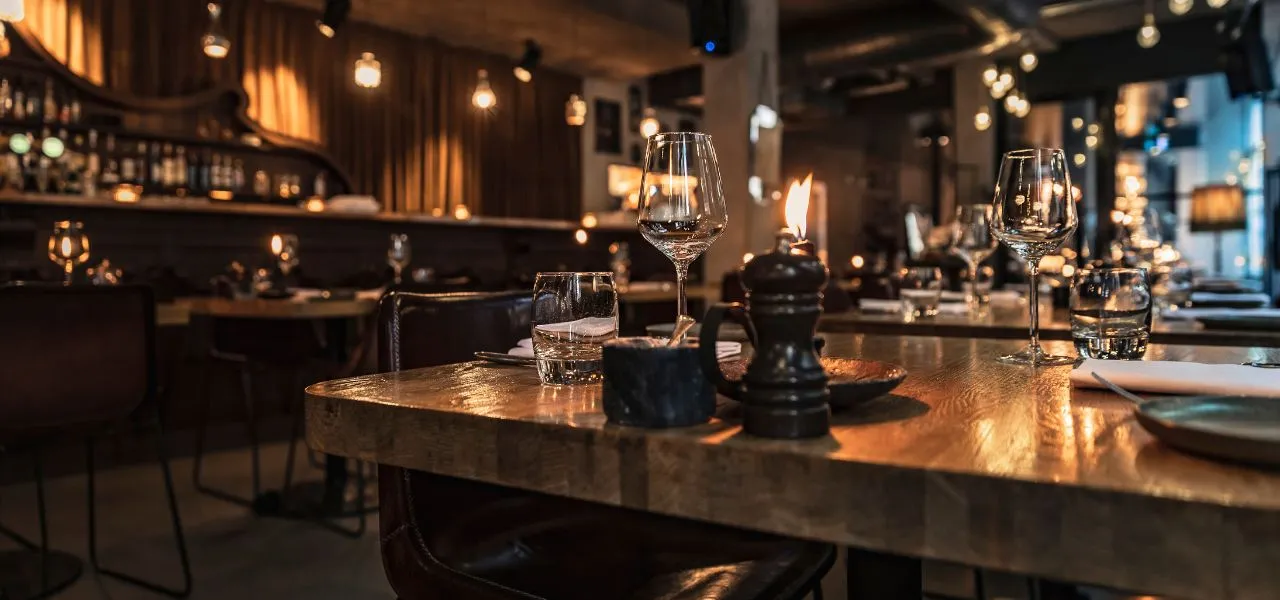A comprehensive business plan is very important for restaurants to handle challenges like unexpected costs, cash flow issues, and keeping customers’ trust. With the right guidance, entrepreneurs can overcome these problems and build a successful restaurant.
This article covers all the necessary sections of a restaurant business plan, with examples and tools to help you create a strong plan. This article help you understand the restaurant industry and achieve your goals.
Following are the important sections with examples of restaurant business plans:
1. Executive Summary
Introduction
Begin by introducing your restaurant, specifying its name, theme, and type of cuisine.
Example: Culinary Creations is a small restaurant that serves modern Mediterranean food.
Business Overview:
Summarize the unique dining experience, highlighting your signature dishes, atmosphere, and what makes your restaurant special.
Example: Culinary Creations offers a unique dining experience with Mediterranean-inspired dishes served in a warm, inviting atmosphere. Our innovative menu features fresh, locally sourced ingredients that redefine classic recipes.
Mission and Vision Statements:
Convey the mission and future aspirations of your restaurant.
Example: Our mission is to provide an unforgettable dining experience with exceptional service and delectable cuisine. Our vision is to become a community favorite, renowned for our creative Mediterranean dishes and welcoming environment.
Location and Accessibility:
Detail your restaurant’s location and how easily customers can find it.
Example: Culinary Creations is ideally located downtown, just a short walk from the central park, making it easily accessible for both locals and tourists.
Type of Service:
Describe the type of service offered, such as dine-in, take-out, or delivery.
Example: Culinary Creations offers an intimate dine-in experience complemented by take-out and catering services for special events.
Key Goals and Objectives:
Outline specific, measurable goals for the short and long term.
Example: Short-term, our goal is to establish a loyal customer base within six months. In the long term, we aim to expand our brand by opening two additional locations within five years.
2. Restaurant Concept and Brand
Restaurant Concept:
Explain the type and theme of your restaurant and why it was chosen.
Example: Culinary Creations is a restaurant that specializes in modern Mediterranean cuisine. This concept was chosen to cater to the growing interest in healthy, flavorful dining options.
Brand Identity:
Define your restaurant’s branding, including logo, colors, and overall image.
Example: Our brand is welcoming and creative. Our logo, featuring a fork and olive branch, shows our dedication to fresh, wholesome food. The colors mix natural tones with bright highlights inspired by the Mediterranean style.
3. Business History & Ownership
Legal Status & Structure:
At this stage, specify the legal structure under which your restaurant operates, as this will impact everything from liability to taxation.
Example: Culinary Creations is structured as a Limited Liability Company (LLC), offering flexibility and limiting personal liability for its owners.
Business Ownership:
It covers the details of who owns the restaurant, their backgrounds, and their roles within the business.
Example: Culinary Creations is co-owned by Maria Rossi and Alex Smith. Maria, a professional chef with extensive culinary training, serves as the executive chef. Alex, with a background in hospitality management, oversees daily operations and customer service. Both share equal ownership and contribute in their own special way to the restaurant’s success.
Key Milestones:
Highlight significant achievements or milestones that mark your restaurant’s progress and growth.
Example: Since its inauguration in 2022, Culinary Creations has reached several milestones. Within the first six months, we doubled our dinner service capacity. In 2023, we launched a successful catering service, contributing to a 20% increase in revenue. Recently, we were nominated for ‘Best New Restaurant’ by a leading local magazine, reflecting our growing reputation and customer satisfaction.
4. Business Model
Main Revenue Sources:
Identify your restaurant’s primary revenue sources, explaining how each contributes to your overall income.
Example: At Culinary Creations, our main income comes from selling food for dine-in and take-out. We also earn a significant amount from catering private events and special occasions. In addition, we sell branded items like aprons, cookbooks, and spice blends, which also add to our earnings.
Supply Chain:
Describe your supply chain, focusing on your partnerships with suppliers and how you obtain ingredients.
Example: We prioritize sourcing fresh, high-quality ingredients from local farmers and suppliers. Our vegetables come from organic farms within a 50-mile radius, and we partner with sustainable seafood providers. These relationships ensure the best ingredients for our dishes and support local businesses.
Special Events:
Discuss any special events or themed nights your restaurant organizes to bring in customers and increase revenue.
Example: Culinary Creations hosts a variety of special events, including ‘Mediterranean Nights’ featuring themed menus and wine pairings once a month. We also host cooking classes and live music events, which have become popular community gatherings, significantly increasing our weekend revenue.
5. Industry Analysis
Current Market Trends:
Analyze current trends in the restaurant industry that may affect your business.
Example: There is a growing trend towards health-conscious dining and a preference for locally sourced ingredients. Culinary Creations aligns with these trends by offering a menu rich in fresh, locally sourced Mediterranean dishes, appealing to health-conscious customers who value quality and sustainability.
Direct and Indirect Competition:
Evaluate your competition, both direct (other restaurants) and indirect (alternative dining options).
Example: Our direct competitors include other Mediterranean restaurants and upscale restaurants in the area. Indirect competitors include health-focused meal delivery services and gourmet grocery stores. However, our unique combination of creative food, excellent service, and community involvement sets us apart and gives us a strong edge over competitors.
Competitive Advantage:
Highlight the factors that set your restaurant apart from the competition.
Example: Culinary Creations stands out with its innovative Mediterranean cuisine, commitment to using locally sourced, fresh ingredients, and an inviting atmosphere. Our personalized dining experience, where chefs interact with guests to explain the inspiration behind each dish, further differentiates us from other dining options.
Positioning and Strategy:
Clarify your restaurant’s market position and the strategy you will use to succeed.
Example: Positioned as a leading Mediterranean restaurant, our strategy focuses on culinary creativity, superior service, and community engagement. By consistently delivering high-quality dishes and maintaining a welcoming environment, we aim to build a loyal customer base and expand our presence in the market.
6. Public Relations and Marketing Strategy
PR Strategy:
Outline how you will gain positive media attention and build a strong community reputation.
Example: Our PR strategy involves hosting media events for new menu launches and special occasions. We will send press releases to local media outlets and engage with food bloggers and influencers by inviting them to exclusive tasting events.
Marketing Plan:
Detail your strategies for attracting and retaining customers through various marketing efforts.
Example: Our marketing plan focuses on a combination of digital and traditional methods. We will utilize social media platforms such as Instagram, Facebook, and Twitter to engage with customers and showcase our dishes. We will also distribute flyers in the local area and place ads in community magazines to reach a broader audience.
Website and Social Media:
Discuss your plans for maintaining an engaging online presence.
Example: Our website will feature our full menu, chef profiles, and an events calendar and allow online reservations. We will keep our social media accounts active with daily posts of behind-the-scenes content, special promotions, and customer testimonials. This will help us connect with our audience and keep them updated on new developments at Culinary Creations.
7. Operations
Staff Hiring and Roles:
Describe your hiring practices, the roles needed, and any training you provide.
Example: We will hire a diverse team of skilled professionals, including chefs, line cooks, servers, bartenders, hosts, and managers. Each new employee will undergo comprehensive training on our service standards, menu items, and safety protocols
Daily Operations:
Detail your daily operational procedures, from opening to closing.
Example: Daily operations at Culinary Creations include pre-opening tasks such as food prep, cleaning, and setup. Once open, hosts will greet and seat customers, servers will take orders, and the kitchen staff will prepare meals. After closing, the team will clean the restaurant and prepare for the next day, and the manager will complete daily sales reports and restock inventory.
Facility Needs:
Discuss the physical requirements of your restaurant and any future expansion plans.
Example: Our facility includes a state-of-the-art kitchen, a comfortable dining area, and a small outdoor patio.
8. Community Engagement
Describe how you plan to build and maintain relationships within the local community.
Example: Culinary Creations will actively participate in local festivals and events by setting up food stalls and sponsoring community activities. We will organize free monthly cooking workshops where our chefs can interact with community members, share culinary skills, and build strong relationships.
9. Financial Plan
Startup Budget/Current Annual Budget:
Provide an overview of your financial status and projections.
Example:
Our estimated budget for the first year is AED 1.5 million. We expect revenue from food and drink sales, hosting events, and selling merchandise. Major expenses include food costs, labor, rent, utilities, and marketing.
Proposed Financing:
Discuss your financial strategy, including plans for managing potential income shortfalls.
Example: Financing for Culinary Creations will come from owner’s equity and bank loans. We have set up a backup fund and a credit line to cover unexpected costs.
Key Financial Assumptions and Justifications:
State your financial assumptions and the reasoning behind them.
Example: We assume a 15% annual revenue growth based on market trends and our marketing strategy. Food costs are expected to be around 30% of total revenue, managed through careful vendor selection and regular waste management reviews. These assumptions are supported by market research and our planned marketing efforts.
10. Appendices
Organizational Chart:
Provide a visual representation of the staff hierarchy.
Example: Our organizational chart shows the structure from owners to managers, chefs, and support staff, ensuring clear roles and responsibilities for efficient operation.
Resumes of Key Staff:
Include resumes or brief bios of key team members.
Example: Attached are the resumes of our Head Chef and General Manager, highlighting their extensive industry experience and contributions to the restaurant’s success.
Detailed Budget:
Include a comprehensive breakdown of your budget.
Example: The detailed budget outlines projected income and expenses, covering all aspects from food costs to marketing expenditures, providing a clear financial roadmap for the year.
Evidence of Market Demand:
Include results from market research or surveys supporting your restaurant’s viability.
Example: Attached is a market survey showing substantial demand for Mediterranean cuisine in our area, underscoring the potential success of Culinary Creations.
Conclusion:
Culinary Creations achieves success with this comprehensive business plan. Our detailed strategies and careful planning ensure we achieve our goals, attract loyal customers, and become a beloved dining spot.
The above discussed is a general business plan for a restaurant, as an example, and if you need a business plan that is customized especially for your business in the UAE, the business setup experts at Now Consultant will create a customized restaurant business plan according to your requirements and market strategy. Contact us for a free consultation to create a business plan for you.









